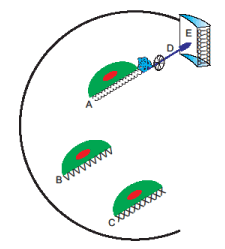
There is an absolute univocal and unambiguous one-to-one correspondence between targeting signal, γ-TuRC receptor, γ-TuRC orientation, MT direction, cell cortex compartment. Signal: undulating line (A) linked to a “twisted-chain” protein; the signal, also named in the text “geometric address” or “ targeting sequence”, is encoded in DNA and, after being transcribed or translated, is contained and displayed in the polypeptide or in the polyribonucleotide (twisted tube) destined for a pre-established cortical localization and recognized by the γ-TuRC receptor (undulating line at the base of the hemi-circle structure, that models the scaffold of the γ-TuRC); different γ-TuRC receptors (B,C) do not fit in with the “undulating” line/signal: they mark γ-TuRCs having orientations corresponding to different directions; orientation of the γ-TuRC itself, from which an MT (D arrow) originates, with a precise direction, points to the desired cell cortex location (E) (thus implicitly encoded in each signal/address). A kinesin carrier (wheel) transports the complex centrifugally. γ-TuRC orientation, MT direction and cortical compartments are the molecular “hardware” of the system whereas signals and γ-TuRC receptors represent the molecular “software”. (From: M. Regolini Centrosome: a geometrical model Lambert Academic Publishing Germany 2014)